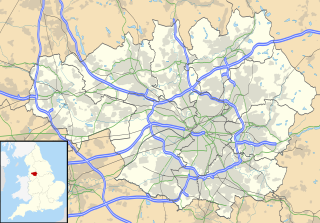History
The stream was referred to in 1570 as Robbyn brooke and in 1754 as Robbing Brook. [2]

The Robin Brook is a small stream originating in the south eastern part of the City of Sheffield in South Yorkshire, England. The source of the stream is in the Charnock area of the city, where it flows south, crossing the border into Derbyshire. It meets The Moss at Ford. [1]
The stream was referred to in 1570 as Robbyn brooke and in 1754 as Robbing Brook. [2]

The stream originates in Charnock, flowing south, almost parallel to White Lane. It then enters Derbyshire at Ridgeway, heading south down Ridgeway Moor, crossing Sloade Lane in the hamlet of Geerlane. The stream then passes under the road at Ford before meeting The Moss. [3]
Two areas along the course of the stream are part of the Moss Valley Meadows Site of Special Scientific Interest (SSSI). The northern area is the largest, and consists of a large area of forest clearings in the Near Hill Clough Wood and the Far Hill Clough Wood immediately to the south of Charnock. The site is located mainly on the southern bank of the Robin Brook, with the clearings in the trees supporting a meadow habitat. The southern area is located further south, close to Hazlehurst Farm, in forest clearings in Parson's Wood and the neighborouring Joshua Holt woodland on the southern bank of the Robin Brook. The SSSI includes a third area, which is located in an area of open land just outside Geerlane, on the southern bank of the Moss just upstream from where the Robin Brook joins it. [4] The three areas are all north-facing, with neutral to acidic soils, and are populated by a rich variety of grassland animals and plants. They are one of the best preserved areas of semi-natural woodland in north east Derbyshire, and include several species which are either local or rare. They have been designated as an SSSI since 1990. [5]
Derbyshire Wildlife Trust is one of 46 local Wildlife Trusts around the UK working to promote and protect local wildlife. It covers the whole of Derbyshire and was founded in 1962 in response to environmental threats to the local countryside, since when it has continued to grow. The Trust is now based at East Mill on the River Derwent in the town of Belper, Derbyshire. It is a Registered Charity, supported by more than 14,000 members and over 500 volunteers.

The Moss is a brook in North East Derbyshire, England.

The Gloucestershire Wildlife Trust is the Gloucestershire local partner in a conservation network of 46 Wildlife Trusts. The Wildlife Trusts are local charities with the specific aim of protecting the United Kingdom's natural heritage. The Gloucestershire Wildlife Trust is managed by a Board of Trustees elected from its membership who provide overall direction for the development of the Trust and there are Advisory Committees. The work of the trust is carried out through staff and volunteers.

Beverley Brook is a minor English river 14.3 km (8.9 mi) long in south-west London. It rises in Worcester Park and joins the River Thames to the north of Putney Embankment at Barn Elms.

The River Darwen is a river running through the towns of Darwen and Blackburn in Lancashire which eventually joins the River Ribble at Walton le Dale. Here the river runs to the south of Preston on its way to the Ribble Estuary on the west coast of northern England.

The West Pennine Moors is an area of the Pennines covering approximately 90 square miles (230 km2) of moorland and reservoirs in Lancashire and Greater Manchester, England. It is a Site of Special Scientific Interest.

Midger is a 65.7-hectare (162-acre) biological Site of Special Scientific Interest straddling the border of Gloucestershire and South Gloucestershire, notified in 1966 and renotified in 1984. Since the last revision in 1974, the size has been reduced to a 56-hectare (140-acre) site. It lies east of Hillesley, Gloucestershire and north of Hawkesbury Upton, South Gloucestershire. It is at the head of the Kilcott Valley.

The Limb Brook is a stream in Sheffield, South Yorkshire, England. It rises at the village of Ringinglow, flowing east through Whirlow and Ecclesall Woods into Abbeydale in the Beauchief area, where it merges with the River Sheaf. Near this point part of the stream has been diverted to provide the goit for the Abbeydale Industrial Hamlet millpond, and this channel flows through what is now Beauchief Gardens.

Burbage Brook is an upper tributary stream of the River Derwent in the Peak District of England.

Cotterill Clough is a 5.6-hectare (14-acre) nature reserve near Manchester Airport. It is managed by the Cheshire Wildlife Trust and lies within a larger Site of Special Scientific Interest (SSSI). The Cotterill Brook, which flows through the reserve, is a tributary of the River Bollin. The reserve was purchased in 1934 by public subscription as a memorial to T. A. Coward (1867–1933), a famous Cheshire naturalist. It is 15 kilometres (9.3 mi) south of Manchester city centre and adjacent to Manchester Airport.

Dymock Woods is a 53-hectare (130-acre) biological Site of Special Scientific Interest in Gloucestershire, notified in 1990. The site is listed in the 'Forest of Dean Local Plan Review' as a Key Wildlife Site (KWS).

Sapperton Valley is a 3.7-hectare (9.1-acre) nature reserve near Chalford in the Stroud district of Gloucestershire, England. The site is managed by the Gloucestershire Wildlife Trust under leasing arrangements with the Bathurst Estate, in place since 1964.
| Wikimedia Commons has media related to Robin Brook, Derbyshire . |
Coordinates: 53°20′23″N1°24′48″W / 53.3396°N 1.4132°W